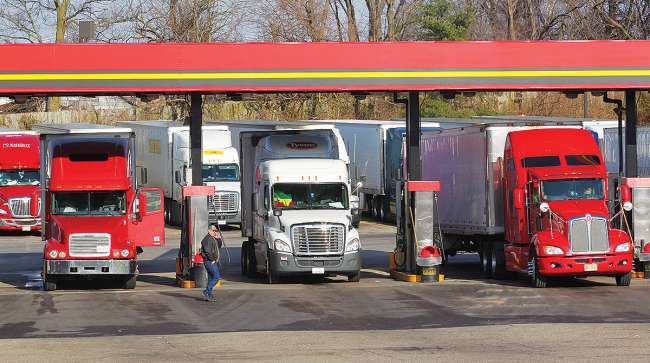Staff Reporter
Diesel Average Drops 3.5¢ to $3.013 a Gallon

The U.S. average retail price of diesel dropped 3.5 cents to $3.013 a gallon, the U.S. Energy Information Administration reported Jan. 7, even as crude oil prices saw renewed vigor and broached the mark of $50 per barrel.
The drop in diesel marked the 12th consecutive weekly decline in the cost of trucking’s main fuel. The price has fallen 38.1 cents during that period.
Diesel costs 1.7 cents a gallon more than it did a year ago, when the price was $2.996, EIA reported.
Average diesel prices fell in all regions of the country, led by the Rocky Mountain region, where per-gallon costs dropped 4.5 cents to $3.026.
The smallest drop was 1.8 cents a gallon, in New England, to $3.216.
The average price of gasoline dropped 2.9 cents to $2.237.
Still, some analysts believe oil prices will fully recover from the December doldrums, and some have been telling Transport Topics for weeks that a barrel of oil would retake the price of $50 as fears of an oil glut subside.
U.S. average #diesel fuel price on 1/07/19 was $3.013/gal DOWN 3.5¢/gallon from 12/31/18, UP 1.7¢/gallon from year ago https://t.co/763sbcTs4W #truckers #shippers #fuelprices pic.twitter.com/bsRMHAWVlu — EIA (@EIAgov) January 8, 2019
“Prices have started to recover,” Denton Cinquegrana, chief oil analyst at Oil Price Information Service, told TT.
And on Jan. 9, oil stormed back into bull market territory, as investors who had abandoned crude just a month ago were lured back by an OPEC-led campaign to bring runaway supplies in check, according to Bloomberg News.
West Texas Intermediate crude closed at $52.36 a barrel, completing a 23% recovery since hitting an 18-month low on Christmas Eve. Brent, the global benchmark, finished the day up 22% since bottoming out, Bloomberg reported.
Driving the rise has been optimism on trade. U.S. negotiators have touted progress in trade talks with China, and investors now believe that OPEC will shrink output, Bloomberg reported.
Cinquegrana said oil prices have gotten back to the highest they have been since Dec. 17. But the increased oil prices likely won’t be reflected at the diesel pumps for weeks, especially because retail demand was not strong of late.
“Diesel demand was very low last week,” said Cinquegrana. “I’d expect to see some kind of rebound in the next few weeks.”
Because of low demand over the holidays, diesel and gasoline inventories have been strong. EIA reported that supplies of distillates, the class of fuels that includes diesel fuel and home heating oil, were up 10.6 million barrels.
Still, diesel prices are higher than gasoline prices, and it’s diesel that is the better bet for refineries in 2019, Cinquegrana said. Diesel likely will show future demand, as coming changes in regulations on maritime fuel begin to cause more diesel to be used, in place of dirtier bunker fuel. Gasoline, on the other hand, shows lesser use by Americans.
“Gasoline is a bit of a dog,” Cinquegrana said. “If you are a refiner, you are trying to produce as much diesel as you can.”
Encouraging traders to bid up oil are American crude stockpiles, which probably declined by 2.7 million barrels last week, according to the median estimate in a Bloomberg survey of analysts. Nationwide inventories are near their lowest level in almost two months, also a sign of growing future demand in 2019.
Cinquegrana also said gasoline and diesel production could slow in coming months because of maintenance schedules at the end of winter and the start of spring.
To buffer against upward changes in diesel prices, Southern Refrigerated Transport in Texarkana, Ark., uses several methods to keep diesel costs down, said Billy Cartright, chief operating officer of Southern Refrigerated Transport.
For one, the company has an internal fuel group shared with its parent company, Covenant Transport Services. The fuel group makes purchases and plans diesel expenditures. The group compares purchases and pricing made within their network with out-of-network purchases. The analysis is done every week, Cartright told TT.
Southern Refrigerated Transport, with 900 trucks, also keeps an eye on idling, a major issue in the trucking industry, especially if traffic causes drivers to sit on the road for long periods.
“We pay close attention to our idling,” Cartright said. “We have monthly idle goals.”
Cartright told TT that idling can burn one-tenth of a gallon every hour. For that reason, Cartright encourages drivers to stick to approved routes.
Southern Refrigerated Transport uses a number of different models made by Peterbilt, Freightliner and Kenworth truck manufacturing companies. The trucks have sleeper berths, and the company specializes in hauling food (especially chicken) to the 48 contiguous states. Because the comfort of the driver is important, the company allows some idling, Cartright said.




